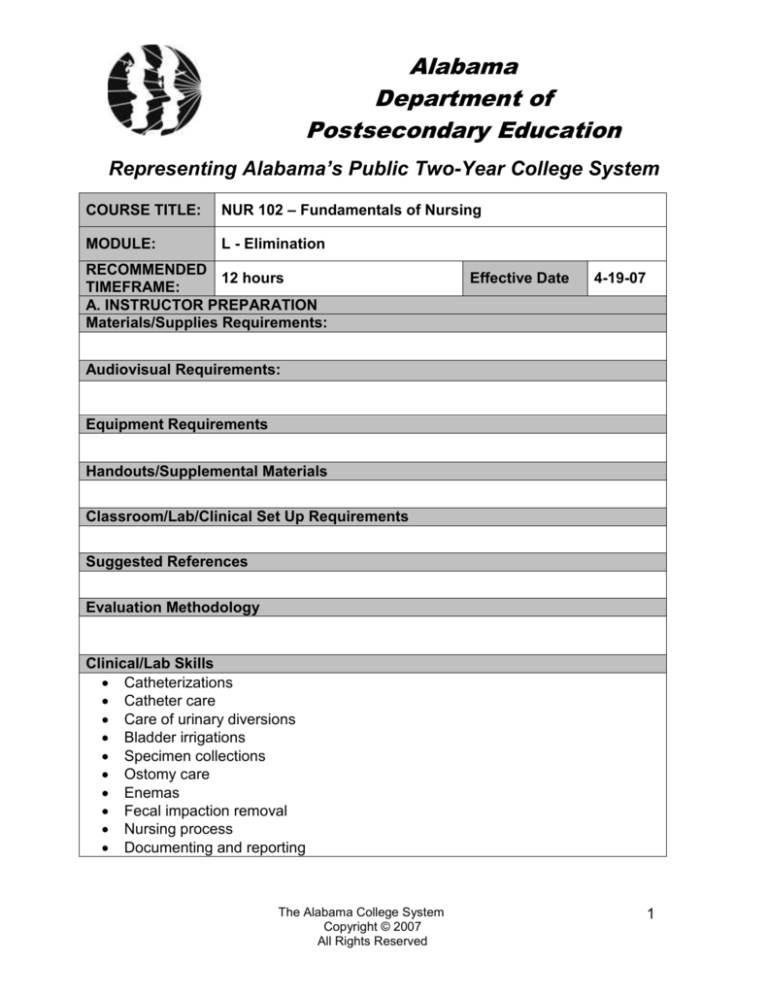
Alabama
Department of
Postsecondary Education
Representing Alabama’s Public Two-Year College System
COURSE TITLE:
NUR 102 – Fundamentals of Nursing
MODULE:
L - Elimination
RECOMMENDED
12 hours
TIMEFRAME:
A. INSTRUCTOR PREPARATION
Materials/Supplies Requirements:
Effective Date
4-19-07
Audiovisual Requirements:
Equipment Requirements
Handouts/Supplemental Materials
Classroom/Lab/Clinical Set Up Requirements
Suggested References
Evaluation Methodology
Clinical/Lab Skills
Catheterizations
Catheter care
Care of urinary diversions
Bladder irrigations
Specimen collections
Ostomy care
Enemas
Fecal impaction removal
Nursing process
Documenting and reporting
The Alabama College System
Copyright © 2007
All Rights Reserved
1
Fundamentals of Nursing
Module L
NUR 102
B. SUGGESTED PRESENTATION METHODS
1. COMPETENCIES AND OBJECTIVES
PROFESSIONAL COMPETENCY
PERFORMANCE OBJECTIVES
L1.0
Promote, maintain, and restore
elimination.
Given scenarios and various clinical settings:
L1.1 Provide interventions to promote, maintain,
and restore bowel/bladder elimination.
L1.2 Apply the nursing process to promote,
maintain, and restore elimination
L1.3 Document and report interventions.
Instructor Notes:
B. SUGGESTED PRESENTATION METHODS
2. LEARNING OBJECTIVES
L11.1.1
L1.1.2
L1.1.3
L1.1.4
L1.1.5
L1.1.6
L1.1.7
L1.1.8
L1.1.9
L1.1.10
L1.1.11
L1.1.12
L1.1.13
L1.1.14
L1.1.15
L1.1.16
L1.1.17
L1.2.1
L1.3.1
Define terms associated with elimination.
Identify procedures for assisting with bowel/bladder elimination.
Identify equipment used for different types of catheterization.
Explain the procedures for different types of catheterization.
Identify types of bladder irrigation.
Identify equipment used for bladder irrigation.
Explain the procedures for bladder irrigation.
Identify types of specimen collection.
Identify equipment used for specimen collection.
Identify techniques for specimen collection.
Identify types of enemas.
Identify equipment used for different types of enemas.
Explain the procedures of performing an enema.
Explain procedures for removing fecal impactions.
Identify the types of ostomies.
Identify equipment used for different types of ostomy care.
Explain the procedures for types of ostomy care.
Explain the process of applying the nursing process to promote, maintain, and
restore elimination.
Explain the process of documenting and reporting interventions related to
bowel/bladder eliminations.
Instructor Notes:
ACS Copyright © 2007
All Rights Reserved
2
Fundamentals of Nursing
Module L
NUR 102
B. SUGGESTED PRESENTATION METHODS
3. LESSON DEVELOPMENT
Theory = T
Lab = L
Clinicals = C
T
T
L
T
L
T
L
T
T
L
T
T
T
T
T
C
1.0 Elimination Terms
1.1 Definitions
1.2 Anatomy & physiology – urinary/bowel
1.3 Factors influencing elimination
1.4 Common alterations
1.5 Nutritional considerations
1.6 Radiologic & diagnostic test
2.0 Assisting with bowel/bladder
2.1 Environmental factors
2.2 Assessment
2.3 Caths/enemas/suppositories
3.0 Equipment for catheterization
3.1 Straight
3.2 Indwelling
3.3 Quick cath
4.0 Catheterization procedure
5.0 Types of bladder irrigations
5.1 Intermittent vs continuous
6.0 Bladder irrigation equipment
T
T
MAIN POINTS
L
7.0 Bladder irrigation procedure
8.0 Types of Ostomies
8.1 Anatomical stoma site
8.2 Single vs double
8.3 Permanent vs temporary
9.0 Ostomy care equipment
10.0 Ostomy care procedure
10.1 Assessment of old vs new
11.0 Types of enemas
11.1 Hypotonic, isotonic, hypertonic
11.2 Volume considerations
12.0 Enema administration equipment
13.0 Enema procedure
13.1 High vs low
13.2 Age
13.3 Position
13.4 Privacy
ACS Copyright © 2007
All Rights Reserved
3
Fundamentals of Nursing
Module L
T
NUR 102
T
T
T
14.0 Types specimen collection
14.1 Urine – mid/stream CC, sterile (UA)
14.2 Urine – special collections – 24 hour, drug analysis, culture
14.3 Bowel – stool analysis – occult, parasite
15.0 Specimen collection equipment
16.0 Specimen collection technique
17.0 Documentation
T
18.0 Nursing process
ACS Copyright © 2007
All Rights Reserved
4
Fundamentals of Nursing
Module L
NUR 102
C. ASSIGNMENTS AND DUE DATES
D. SUMMARY AND REVIEW
ACS Copyright © 2007
All Rights Reserved
5








